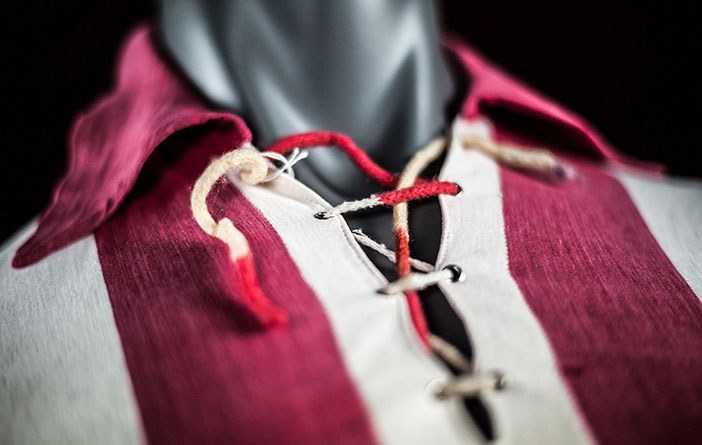
Athletic Club shirt´s design through the history
Athletic Club shirt´s design through the history
For most of the history of the Club, referred to equipment, the focus of shirt…
For most of the history of the Club, referred to equipment, the focus of shirt design was on maintaining the red-and-white pattern of vertical stripes. No consideration was given to aspects that designers play with today to create sportswear with a particular seal. A series of elements have modified the appearance of the clothing and have made possible to see an evolution of the design over the years.
-Stripes
On one hand, it is possible to distinguish the number and thickness of the stripes on the front, determine whether they are even or odd, and, in the latter case, to differentiate the colour of the central stripe, either red or white.
On the other hand, although white hardly admits any nuances, the range of reds, from the most intense and lively to those close to maroon, has meant another differentiating criterion, especially in recent years.
-Neckline
The collar type is an important element because, although it is only the top of the garment, it gives a differential seal. In principle, three basic classification criteria can be established: shirt collars, round collars and v-necks.
-Camisole or shirt
Although shirts with open or semi-open collars and buttoned in the style of shirts have not been stylish for decades, they were the dominant trend until the 1960s. From 1970 onwards, the T-shirt became a fashionable pattern.
-Pocket, cuffs, backs, shield, logo, advertising and other details
From 1930 until the 1960s, pockets were frequent at left chest height. (…) The cuffs of the long-sleeved garments have also varied parallel to the pockets.
Bibs officially arrived at the uniforms in 1948. The first league in which Athletic wore the shield on their red-and-white outfits was 1974/75.
Finally, the advertising for the lions’ uniform arrived in the 2008/09 season and Petronor was the advertised sponsor. Previously, in the 2004/05 campaign and in the UEFA Cup competition, Euskadi was promoted on the shirt, but as it was something institutional and not commercial, it was not considered advertising per se.
-Fabrication
There is a big difference between those shirts that were designed and manufactured “without brand” only for the football player’s use, and those other clothing that, in addition to their professional sports use, were conceived with manufacturer’s brand also for subsequent public marketing. The consequences of this different general conception affect both design and manufacture. It is not the same thing that a local tailoring or textile factory makes 100 garments from the same red-and-white fabric, as could happen until the 1970s, to a multinational that wants to sell thousands and thousands of T-shirts in all possible sizes and in very different markets.
4 big periods
1. 1911 1920 Diversity
Until the 20s there is no a unified pattern. Some players wore shirt collars whereas some others V-necks with cords.
2. 1920 1970 From t-shirt to polo shirt
For 50 years, a design similar to a shirt has been established, characterised by the use of collars and buttons. The evolution of this attire, in general, is similar to the evolution in fashion from the shirt to a polo shirt. On one hand, the buttons disappear in 1967, but the collars and the V-shaped clasp remain.
3. 1970 1980 Towards sporty and commercial design
In the 1970/71 season, Athletic Club abandoned the collars and camisole or polo shirt appearance and for the first time they wore a T-shirt with a white round neck. It is the first step towards a modern design that already in the 80’s would cause the growth of international brands destined to the manufacture of exclusively sports garments.
4. 1981-Today. Apogee of sport brands.
In the 1981/82 season, Athletic Club t-shirts wore the Adidas brand logo for the first time. It was the beginning of a new era. Now, brands are paying for dressing the teams and the benefit is obtained by massive commercialization of garments. To this end, every year a new model is launched (in Athletic since 2007) and apart from the first clothing, second and third equipment are also commercialized, as well as exclusive designs of the different competitions or matches.
